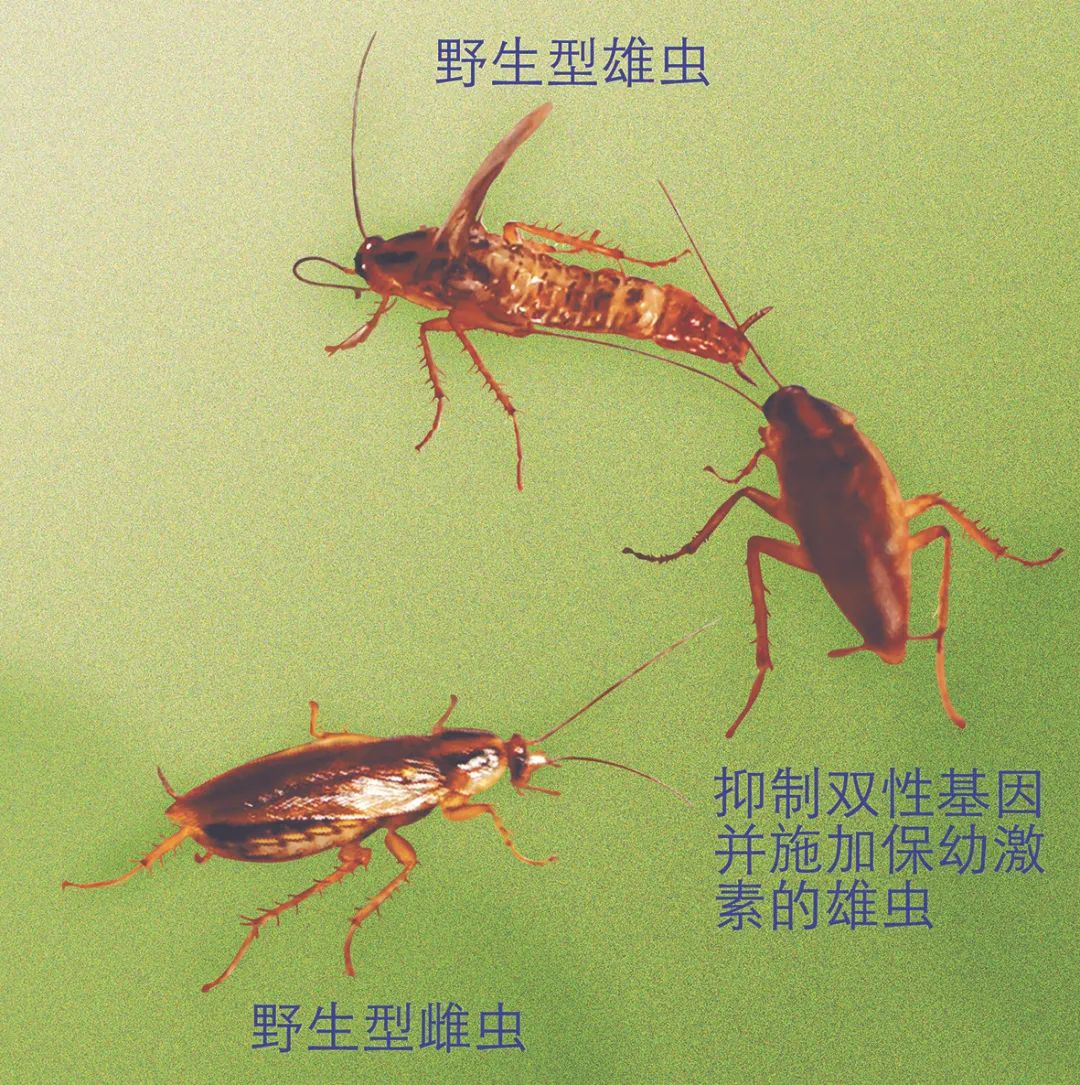Xiaoyu's "Marriage": the life of genes, hormone words
Author:Journal of China Science Time:2022.07.06
Text | "China Science News" reporter Li Chen Zhu Hanbin

Figures of the interviewee confession of competition for behavior analysis
"Guan Guanjiu, in the continent of the river. Lady, a gentleman is good." The Book of Songs describes the complex behavior of human love, and the love and marriage in the insect world is much simpler.
On July 4, "Nature -Ecology and Evolution" published the cooperation and research results of South China Normal University and Northwestern Agriculture and Forestry University of Agriculture and Forestry Science and Technology. They identified the most critical genes that control the contact of German Xiaoyan (the most common world -class home pests) in Germany (the most common worldwide home pests), and the system reveals the molecular mechanism of its sexual attractiveness -whether there is charm, gender is fundamental fundamental is fundamental. And, hormone levels are indispensable for maintenance.
The research results provide new opinions for understanding the generation and complex control of animal signals. Xavier Bellés, an academician of the Royal Academy of Sciences in Spain, said in the thesis review, "Obviously, this work has surpassed the category of cockroaches or insects, and implies the general problems of how the sexual differences between the sexes of animals."
"One touch of love": Xiaoyu's love skills
"The driving force for the choice of gender as animal sex includes both the generation and release of sexual signals, but also the effective identification and reception of sexual signals of heterosexual individuals. Gender differentiation and hormones are crucial The complicated genetic regulation network. "Li Sheng, the author of the responsibility of the paper, and the professor of South China Normal University, told the Journal of China.
Among high -level animals such as human beings, behaviors such as love and puppets involve complex signal systems, including visual, hearing, touch, and even psychological and social factors.
In order to simplify the complexity, scientists chose insects that rely on chemical signals to trigger puppet behaviors as research objects.
The first author of the paper, Chen Nan, an associate researcher at South China Normal University, told the Journal of China that the characteristics of small sexual behavior in Germany's small sexual behavior and clear sexual phenomenon components were a good model system for studying the two -sex chemical communication mechanism.
Fan Yongliang, the author of the paper and a researcher at Northwest Agricultural and Forestry University of Agriculture and Forestry, said in an interview with the China Science Journal that Germany's small puppets carried more than 40 pathogenic microorganisms, which is a common family sanitary pest. Because it has strong drug resistance and high fertility, it is very difficult to control.
"Many insects rely on volatile information to search for spouses long -distance, and use contact pheromone for close -range consistency. The sexual seductive agent with sexual pheromone is an efficient and green biological prevention method, which has a good application prospect." Fan Yongliang said.
As early as 30 years ago, scientists began to "worry" the problem of "marriage" in Germany.
Studies have found that the male is crazy about 29 carbon atomic long -chain lipid mixtures, which is very different from the well -known volatile pheromone.
"These low -volatile sexual phenomena must be accepted through male and female physical contact. The male uses the tentacles to perform the" sword strike "to identify the female pheromone, and then stimulates the males and induce bisexual mating behaviors." Chen Nan said, " This is like "a love".
In 1992, the Blomquist Laboratory of Neva University in the United States proved the most of the methamphetamine of sexual mature females in the biochemical level using homicide traceing technology, which was generated by a hydroxylatin and oxidation reaction. This hydroxygenization reaction is a female specific step.
"This step has been responsible for the P450 gene that is considered by a female specially expressed since 1992, but it has not been identified before." Li Sheng said.
In 2018, the high -quality genomic map of the German Xiaoyan was published publicly; in 2019, Fan Yongliang's team conducted sequencing in multiple developmental stages of German Xiaoyu. "The continuous progress of sequencing technology and the reduction of costs, and the in -depth application of group learning methods allows us to have the opportunity to verify the function of this P450 gene -the function and the correctness of the assumptions of the year after 30 years." Chen Nan said.
Molecular "password" for controlling pheromone
Earlier, it was believed that the colorful cells under the skin of the German small 蠊 are the main places for the combination of contact pheromone. This allows the research team to find genes that may be highly expressed in skin tissue in the skin tissue.
Through a large -scale screening of the transcription group, they found the CYP4PC1 gene in more than 80 P450 gene families.
However, the next verification has made them an amazing discovery -the gene is high in the tentacles and wings of the female, and the mature content can reach hundreds of times at the age of one day. "So, female tentacles and wings are the main places for the combination of contact pheromone. This conclusion has overturned the previous view." Chen Nan said.
Chen Nan introduced that they expressed the low expression of CYP4PC1 genes, which can lead to a significant reduction in the content of female contact in contact, and male insects no longer show the dopy behavior of these females.
"These results show that CYP4PC1 is necessary for the maintenance of sexual phenomenon synthesis and sexual attractiveness of females, and it is likely to participate in the hydroxylated response of contact information anterior body substances." Li Sheng said.
In order to further prove that CYP4PC1 controls this decisive hydroxylated steps, the team subsequently detects whether the gene is regulated by the insured young hormone signal.
The research results show that the CYP4PC1 gene plays a decisive role in the German small pheromone synthesis path. At the same time, the content of the genetic and contact pheromone of the gene is coordinated by gender differentiation genes and young hormone signals. Why do male insects "extinguish the lamp" to the male
In fact, male worms also have high content of contact pheromone anterior compounds. So, why can't the male be like a female synthetic pheromone?
They found that a small part of the male insects can attract the males after replenishing the high -dose exogenous young hormone that lacks young hormones.
"This shows that young hormones can induce male insects to substantially express the CYP4PC1 gene and synthesize contact pheromone, but the effect is very limited." Chen Nan analyzed that there may be more important factors inhibiting the expression of CYP4PC1 genes in the male.
It was found that the specific expression of the CYP4PC1 gene in the females was regulated by the upstream gender differentiation signal pathway. In the German sip, the bisexual gene Doublesex will produce different protein DSXF and DSXM in the male and female adults, respectively. Among them, the male -specific product DSXM protein can be combined with the CYP4PC1 gene promoter to suppress its transcription.
When they inhibit the expression of bisexual genes in male adults, they can lead to typical homosexual behaviors in the German small. In order to further verify, they expressed lowly these male CYP4PC1 genes, so homosexual behavior disappeared.
This shows that among the male adults, DSXM protein inhibits the expression of CYP4PC1 genes, and the male worm is relatively lacking in young hormones. The two jointly curb the synthesis of contact pheromone in the male, thereby avoiding the attraction of wild male mackerels.
"At this point, we have proved that by manipulating upstream regulatory factors, wild male worms prefer to express the amount of cockroaches with higher contact with CYP4PC1 and contact with high contact pheromone content, and this preference has nothing to do with the latter's gender. Mature female is more attractive. "Li Sheng said.
"Gender is fundamental, and hormone levels are indispensable for sexual attractiveness." Fan Yongliang said.
Chen Nan said, "Why can't male cockroaches attract male cockroaches? Because of its" feminine gene 'was closed. Why do male cockroaches prefer to be sexually mature female cockroaches? Because its "endocrine" level is high. "
The paper reviewer agreed that the work was an important breakthrough in the field of insect chemical ecology and reproductive physiology. "The result of the paper reliably proves the regulatory role of key genes CYP4PC1, which is likely to promote the research of key regulation genes of other animal bisexual communication systems."
Related thesis information:
https://doi.org/10.1038/s41559-022-01808-w
"China Science News" (2022-07-06 The first edition of the news)
Edit | Zhao Lu
Capture | Zhihai

- END -
The strongest desert highway in history, 40 earthen machines pushed 150 days of sand!

Produced | NetEase NewsIntroduction: What do you think of in the face of the vast ...
Has the logic of praise changed?

China's Internet has developed for more than 20 years, from opening up to closure,...